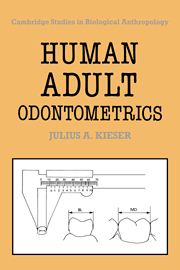Book contents
- Frontmatter
- Contents
- Foreword
- Preface
- 1 Introduction
- 2 Measurement of tooth size
- 3 Inheritance of tooth size
- 4 Comparative odontometry
- 5 Odontometric trends
- 6 Sexual dimorphism in tooth size
- 7 Odontometric variability
- 8 Compensatory tooth size interactions
- 9 Fluctuating odontometric asymmetry
- 10 Allometric relations of tooth size
- Odontometric appendix
- References
- Index
1 - Introduction
Published online by Cambridge University Press: 05 February 2012
- Frontmatter
- Contents
- Foreword
- Preface
- 1 Introduction
- 2 Measurement of tooth size
- 3 Inheritance of tooth size
- 4 Comparative odontometry
- 5 Odontometric trends
- 6 Sexual dimorphism in tooth size
- 7 Odontometric variability
- 8 Compensatory tooth size interactions
- 9 Fluctuating odontometric asymmetry
- 10 Allometric relations of tooth size
- Odontometric appendix
- References
- Index
Summary
Teeth provide a wealth of information relevant to a great variety of biological problems; they therefore attract the attention of the zoologist, the human biologist, and many others. The fact that dental dimensions have fascinated such a wide range of scientists is reflected in the spectrum of journals that contains results of their endeavours. Hence, the major purpose of this book will be to unite these diverse data into one single, easily accessible source.
Tooth length and width constitute the most widely documented of anthropometric features. These two measurements provide significant information on such human biological problems as the genetic relationships between populations and human environmental adaptation. As an experimental system, they serve as a test-bed for craniofacial dental procedures, whilst as an evolutionary entity, they aid in solving questions of comparative anatomy and phylogeny.
Because of their durability, teeth and bones are the last structures to disintegrate after death. Hence they contribute an inordinate body of evidence for the evolutionary anthropologist, the archaeologist or the forensic expert to rely on. Dental material is much less destructible than osseous material, so that collections of proto- and prehistoric human remains have come to contain disproportionate numbers of teeth. For example, from his census of the skeletal material derived from fourteen African hominid sites, Tobias (1972) concluded that teeth constituted about three-quarters of the total sample. In fact, our knowledge of early humans has largely been built around our knowledge of fossil teeth. Forensic experts have come to rely heavily on dental evidence for the identification of the victims of natural and unnatural disasters.
- Type
- Chapter
- Information
- Human Adult OdontometricsThe Study of Variation in Adult Tooth Size, pp. 1 - 3Publisher: Cambridge University PressPrint publication year: 1990



